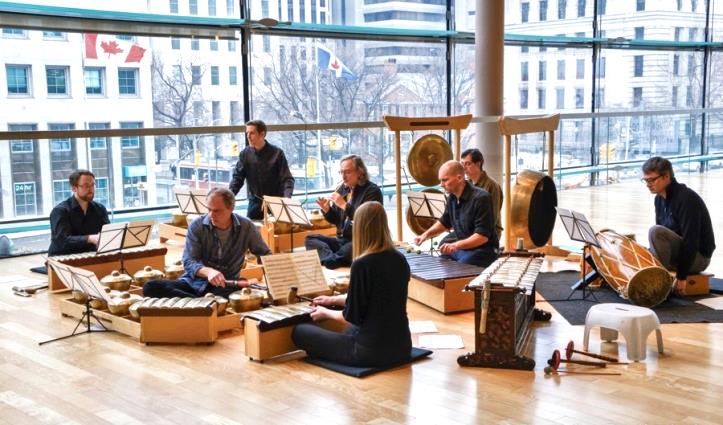How it Storms: A Personal Perspective on a Milestone in Canadian Opera – with a World Music Spin by Andrew Timar
Evergreen Club Contemporary Gamelan performs at the Bradshaw Amphitheatre, Canadian Opera Co., March 2015.
“Better to blaze, even for a moment, than to smolder forever with desire.” That is how the creative team of award-winning Canadian composer Allen Cole and librettist Maristella Roca describe the story of their “mature erotic” opera How it Storms (2001). Its new staging was made possible with the support of the Canada Council for the Arts and the Ontario Arts Council. Scored for four voices and gamelan degung (indigenous to West Java, Indonesia) and inspired by the Hindu epic The Mahabharata, it will be premiered on June 17 and June 18, 2015 at the ArrayMusic studio in downtown Toronto.
The production is enhanced by screen projections created by Richard Sacks, who also directs. The story is set in an evolving landscape – first primeval, then urban and ultimately dystopian – the video images heightening the narrative’s dramatic impact. Moreover the notion of the East, as reflected by the sight and sound of the gamelan and in the roots of the opera’s story, is seamlessly blended with the Western singers’ voices and performance aesthetics embedded in How it Storms.
I have lived with this commanding work for 15 years now. Even though I’m thus entirely biased, I have had plenty of opportunity to critically consider its impact. My journey with How it Storms began with its genesis during the closing years of the 20th century. Its composer Allen Cole joined Gamelan Toronto, the Central Javanese community gamelan group I coordinated at the time, for a few months as a singer in the gerongan (chorus) and an occasional gamelan player. (Please see my previous TWAS articles on aspects of the Ontario gamelan music scene.) The commission of the work in 2000 by Toronto’s Evergreen Club Contemporary Gamelan (ECCG) was its next significant milestone. Its development continued in subsequent singer try-outs, revisions, scorings and rehearsals, the final phase of which in which I was happily involved in as ECCG’s suling (ring flute) player. I addition, I was also called upon by the score to play several other gamelan degung, a type of gamelan (orchestra) indigenous to West Java, Indonesia, and to sing.
It wasn’t until How it Storms’ thrilling premiere at the Royal Conservatory of Music, Toronto in 2001, however, that I first heard the drama of the music unfold in its complete lyrical and gamelan-rich instrumental glory. Another “on-book” concert performance and recording a few years later at Toronto’s Music Gallery confirmed my initial insider impression that this was an not only an outstanding work of Canadian music theatre, but also a ground-breaking transcultural work. It’s the only four-character opera with gamelan degung for its instrumental accompaniment\ I know of.
How it Storms’ upcoming 2015 production, its third, by Toronto’s Evergreen Club Contemporary Gamelan in association with ArrayMusic, features four rising stars of the Canadian opera scene. Recently confirmed, they are Claire de Sévigné (soprano), Danielle MacMillian (mezzo-soprano), Christopher Mayell (tenor) and Keith O’Brien (baritone). The vocal quartet is joined by eight members of the pioneering world music ensemble Evergreen Club Contemporary Gamelan under its Artistic Director Blair Mackay. The group’s set of elite instruments handcrafted in both Indonesia and in Toronto in 1999, called a gamelan degung, is characterised by the brilliant sounds of bronze and wooden tuned percussion, moody suling (bamboo ring flute) and the plucked strings sounds of the kacapi (20-string zither).
Director and video set designer Richard Sacks’ interpretation of Roca’s libretto leans toward a feminist reading. Based on fragments of stories from the Mahabharata, this production portrays the story’s primary protagonist Coco as a modern bride motivated by a desire to win her freedom from patriarchal domination. According to talks we had in May 2015, Sacks spoke of exploring dark psychological waters. He’s diving into themes of “self-destructiveness, greed, lust and hunger for power” which motivate each of the four characters, tapping into deep transcultural mythologies that “define the human condition.”
Sacks is not only a leading Toronto percussionist and active composer, but also the Artistic Director of the veteran avant-garde Toronto music ensemble ArrayMusic. As a gigging percussionist he regularly performs with Arraymusic, Art of Time, Aventa, Evergreen Club Gamelan, Glass Orchestra, New Music Concerts, Red Sky Performance, among other groups, and has extensively toured in Europe and Asia. In 2010 Sacks received a Dora award for his music score for TONO (Red Sky Performance).
The composer of How it Storms, Allen Cole, is a true man of the theatre, working variously as a composer, musical director, lyricist and book writer for music theatre. His distinguished credits include The Wrong Son for the National Arts Centre, Anything That Moves, and Pélagie for the National Arts Centre and CanStage. In addition Cole has composed incidental music for many Canadian theatre companies including the Shaw Festival, Stratford Festival and Soulpepper. His musical The Miracle Man was nominated for six Merritt awards and walked away with two. His numerous awards, which also include four Doras, reflect the high esteem his work is held in by the theatre community. His day job: teaching musical theatre at Ryerson University, Toronto.
In his innovative score for How it Storms Cole sets lyrical yet virtuoso operatic vocals against sparkling instrumental music skillfully performed by ECCG’s musicians.
The How it Storms’ creative team also includes librettist Maristella Roca. She has collaborated with Cole and Sacks on various theatrical projects. As a playwright, Roca has twice received the Floyd S. Chalmers award for Outstanding New Play. Her adaptation of Pinocchio is published by Playwrights Canada Press and she has held Playwright Residencies at numerous Canadian theatre companies across the country including Theatre Passe Muraille, Factory Theatre, Tarragon’s Playwrights Unit, Playwrights’ Workshop Montreal, Playwrights Theatre Co. Vancouver and many others. Roca describes her partnership with Cole on How It Storms as one which is a culmination of her “life-long desire to love out loud.”
Directed by Blair Mackay ECCG has carved out a unique niche as a gamelan group dedicated to the commissioning and performance of contemporary music in the Euro-American tradition. It also has an extensive repertoire from West Java which the group’s musicians have adapted and arranged to suit its unique Canadian hybrid approach. Established in 1983 and based in Toronto, ECCG is Canada’s first performing gamelan of any kind. Its eight accomplished Canadian musicians, who also play in other prominent musical ensembles, perform and record with ECCG performing on its bespoke bronze, wood, stringed and bamboo Indonesian instruments.
Over its 32-year career ECCG has commissioned and premiered over 250 works by leading modernist and postmodernist composers including John Cage, Gilles Tremblay, Linda Catlin Smith, Walter Boudreau, Lou Harrison, James Tenney, Michael Oesterle and Ana Sokolovic, to mention only a few. In 1987 the Evergreen Club released the LP North of Java, the first Canadian gamelan album. Today ECCG counts 12 album credits, with two more waiting release. The group has continually engaged with diverse solo musicians and leading ensembles, ranging across many global genres. More recently it has appeared on stage and recordings with the experimental turntable duo iNSiDEaMiND and the rapper-songwriter Abdominal.
ECCG has toured extensively throughout North America, Europe and Asia, often serving to strengthen transnational ties through the transcending power of music. In 2002 the Canadian group was invited to perform in Indonesia – the home of gamelan music – honouring 50 years of bilateral relations between the two countries. It music is at home in the movies as well. Beginning in the 1990s film composers began to include ECCG’s instruments and musicians in their scores. That catalogue includes several Hollywood feature films: Denzell Washington’s Antwone Fisher (2002), Ang Lee’s films The Ice Storm (1997) and Life of Pi (2012). The latter score won an Oscar for Canadian composer Mychael Danna.
I recently spoke to Blair Mackay, ECCG’s Artistic Director. He’s a percussionist veteran with some four decades in the business, who has directed the group since the early 1990s. He proudly told me that this new How it Storms production continues ECCG’s “commitment to the further development of its innovative commissioning, performing and recording projects,” reaching out to audiences interested in exploring musicking across cultural boundaries.
I look forward to reigniting my involvement as a musician with this musically satisfying work which the composer Cole noted fondly “is a special milestone in the extensive catalogues of the composer, the librettist, and the ECCG.”
More information about the How It Storms team can be found at http://www.arraymusic.com/how-it-storms


